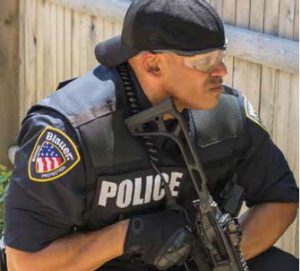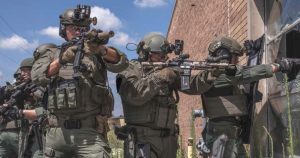More police officers are wearing more body armor more often. Multiple factors contribute to this safety gear’s increased use.
Unequivocally, far more weapons are on the streets today than there were a generation—or even a decade—ago. According to the nonpartisan Congressional Research Service, there are about twice as many guns per capita in the United States—more than 300 million total—than there were in 1968.1 The Bureau of Alcohol, Tobacco, Firearms and Explosives estimates that about 9 million guns were manufactured in the United States in 2014, compared with 5.5 million produced in 2010.2 According to FBI data, firearms were used in 41 percent of all U.S. robberies—far more than any other weapon category.3
At the same time, in some quarters, public sentiment increasingly favors a more community-oriented approach to policing, which can mean eschewing militaristic law enforcement tools—like heavy body armor—that had previously gained favor over the past decade or more. Implemented improperly, this cultural shift could potentially render officers more vulnerable to attack.
Luckily, however, many U.S. manufacturers have recognized and are responding to these trends. Lighter but still powerful body armor can protect officers while increasing comfort and making officers more approachable to citizens to improve community-police relationships.
Maximizing Comfort
In 2010, the U.S. Department of Justice, through its Bulletproof Vest Partnership program, mandated that law enforcement agencies require officers to wear body armor while engaged in patrol or field operations if those departments wished to receive federal reimbursement (up to 50 percent of total costs) for body armor purchases.4 Ever since, “mandatory wear” policies have been springing up across the United States, leading to greater demand for and utilization of body armor.
According to experts, however, having these policies in place doesn’t necessarily mean officers are following through. Heavier, less-comfortable armor can drive down the rates of compliance.
“A lot of departments have mandatory wear policies, but the reality is that a lot of officers don’t do it,” said Scott Wyatt, vice president of sales and marketing for Armor Express, a body armor manufacturer based in Central Lake, Michigan. “[Officers] find an excuse to unzip those vests, and then they’re vulnerable.”5
Police departments, looking for ways to increase compliance with the policies, turned to manufacturers, who then ramped up efforts to make body armor more “wearable” without sacrificing safety.

“It’s just gotten to the point where it’s just too dangerous not to [wear body armor],” said Stephen Blauer, owner of Blauer Manufacturing Company, based in Boston, Massachusetts. “To make it comfortable, we’ve tried to explore ways to wear the armor away from the body.”6
For Blauer, the answer was ArmorSkin, an outer vest cover billed by the company as the only product of its kind that can accommodate all armor brands, makes, and models. The three-part armor concealment package moves armor to the outer layer of a uniform shirt. This increases range of motion, improves comfort, prevents back stiffness and skin rashes, and helps officers maintain a professional appearance.
“It looks like a normal shirt, but it’s stretchy and athletic, with quick-dry fabric,” Blauer explained. “You throw the vest over your head and go out… It’s a huge shift in the way officers are dressing.”7
At Armor Express, which manufactures the armor itself, the company’s Razor and Vortex models are billed by company leaders as “the most comfortable armor in the world.”

“Our focus on comfort and wearability is what we’re most proud of,” Wyatt said. “That enables [law enforcement officers] to do their job that much better. We want to protect but not hinder in any way.”8
According to Wyatt, Razor and Vortex armor models can lead to a decrease of as much as 25 percent in the weight of body armor, and can cut fatigue levels in half. “If you have a 12-, 14-, or 16-hour shift, they feel fresher and less fatigued,” Wyatt pointed out.9
Low-profile armor also helps enhance safety from a strategic standpoint. “The police officer maintains their tactical advantage,” Blauer said. “It’s often difficult to tell whether they have armor on or not, and in a gun battle, we want perpetrators to aim for the mass of the body where the armor tends to be, rather than the head. If it’s obvious you have a vest on, [shooting for the head] is more likely to happen. This [low profile] camouflages the vest.”10
According to company statistics, sales of ArmorSkin have increased 30 percent each year since its initial rollout. That’s a testament to the value departments see in the technology, as well as the benefits reaped.
As a result, both Blauer and Armor Express are planning to roll out new options in the coming months.
“We’re planning to introduce a product that allows quick and easy up-armoring with plates,” Blauer said. “You add plates to the ArmorSkin, unzip a pocket, drop a plate in it, and now you’re fortified.”11
New technologies are also rolling out to protect the heads of officers. Ops-Core, a brand created by Pennsylvania-based Gentex Corporation, is an industry leader in state-of-the-art helmet systems. Tested and manufactured in-house, Ops-Core’s ballistic and non-ballistic helmet shells provide optimal protection while allowing maximum customization based on individual customer needs.
Fostering Trust
Officer safety is always a top priority, but there are other factors at work in the gear selection process for agencies. After high-profile incidents between police and citizens, community policing tactics are in the spotlight.
As a part of this trend, community policing advocates have decried what they claim is an excessively and unnecessarily militaristic carriage or appearance among police, even when it is not relevant to a given situation.
“Given the current climate of law en-forcement, there has been a pushback on appearance if you’re engaging with the public,” said Ken Aker, chief operating officer at Aker Leather Products. “Officers need to look the same and act the same. Having the right gear and having that look is important. We’re here for them, not against them. The leather conveys that better than nylon.”12
In its Chula Vista, California, factory, Aker artisans produce a range of law enforcement leather goods from holsters to handcuff cases. Aker clients include the Los Angeles Police Department, California Border Patrol, and the U.S. Border Patrol, and Aker notes that one of the advantages his customers point to—alongside comfort, durability, and lower maintenance compared with synthetic items—is the way in which leather imparts a traditional community policing appearance.
“One of the things we put a lot of effort into is quality control,” Aker said. “For example, every edge on our handcuff case is sanded smooth and then burnished so it looks like one piece. People may not understand the specifics of what we do, but they understand the craftsmanship. It really translates.”13
In more ways than one, the new capabilities of body armor and related goods may be emblematic of a changing law enforcement culture, one in which new scrutiny, new demands, and new technologies are converging to shape the profession. Body armor manufacturers appear to see all of these forces as an advantage that can be leveraged for police and their indispensable work.
“Now with more community policing, police officers need new solutions for when they’re out on foot for eight hours,” Wyatt said. “Thinner, lighter thread plates that offer light rifle protections and don’t give off the appearance of a militaristic look. Weights and thinness have gotten better. [Armor] used to look like a phone book on your chest, now the public doesn’t even know it’s being used.
“We’re only expecting more of this in the future.”14 ♦
Notes:
1 William J. Krouse, Gun Control Legislation (Washington, D.C.: Congressional Research Service, 2012), https://fas.org/sgp/crs/misc/RL32842.pdf.
2 U.S. Bureau of Alcohol, Tobacco, Firearms, and Explosives (ATF), Annual Firearms Manufacturing and Export Report, 2010, https://www.atf.gov/resource-center/docs/2010-final-firearms-manufacturing-export-reportpdf/download; ATF, Annual Firearms Manufacturing and Export Report, 2014, https://www.atf.gov/firearms/docs/afmer-2014-final-report-cover-revised-format-2-17-16/download.
3 Federal Bureau of Investigation, “Robbery,” Crime in the United States, 2012, https://ucr.fbi.gov/crime-in-the-u.s/2012/crime-in-the-u.s.-2012/violent-crime/robbery.
4 U.S. Department of Justice, “Updated Frequently Asked Questions (FAQs) for the BVP Program Mandatory Wear Requirement,” https://ojp.gov/bvpbasi/docs/FAQsBVPMandatoryWearPolicy.pdf.
5 Scott Wyatt (vice president of sales and marketing, Armor Express), telephone interview, December 21, 2016.
6 Stephen Blauer (owner, Blauer Manufacturing Company), telephone interview, December 21, 2016.
7 Ibid.
8 Wyatt, telephone interview, December 21, 2016.
9 Ibid.
10 Blauer, telephone interview, December 21, 2016.
11 Ibid.
12 Ken Aker (chief operating officer, Aker Leather Products), telephone interview, December 20, 2016.
13 Ibid.
14 Wyatt, telephone interview, December 21, 2016.


